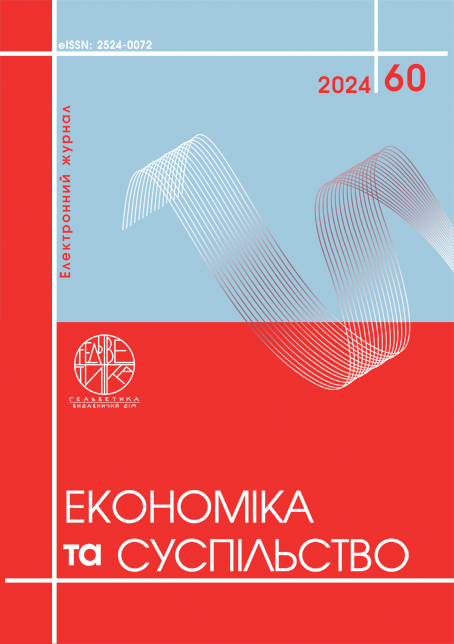CLUSTERING OF EU MEMBER STATES BY THE LEVEL OF DEVELOPMENT OF INSTITUTIONAL INVESTOR ASSET MANAGEMENT
Abstract
The financial landscape within the European Union is characterized by a significant disparity in the development of institutional investor asset management across its member states. Institutional investors, such as pension funds, insurance companies, and investment trusts, are vital in shaping financial markets and influencing economic stability. This study aims to fill the gap in the existing literature by examining the grouping of European Union member-states. The research focuses on examining key attributes, trends, and performance indicators of institutional investor asset management across various EU member-states. It utilizes data from 2017 to 2022, reflecting the average values of financial assets held by institutional investors as a percentage of Gross Domestic Product (GDP). This data provides a critical perspective on the investment landscape within the EU, particularly focusing on investment funds and insurance corporations. A notable observation from the data is the significant variance in the financial assets to GDP ratio among EU countries, with Denmark and France showing exceptionally high ratios, indicating a substantial role of institutional investments in their economies. In contrast, Lithuania and Greece demonstrate much lower ratios. This disparity is further analyzed through cluster analysis, grouping EU member-states into five clusters based on their asset management profiles. The clusters reveal distinct patterns in the distribution and development of asset management across the EU. Countries like Denmark and France, with highly developed financial markets, contrast sharply with those like Lithuania and Greece, which have less mature markets. The study highlights the influence of various factors such as economic structure, regulatory environment, and cultural attitudes towards savings and investment on these disparities. The study suggests that future research should focus on developing comprehensive policy recommendations, taking into consideration the distinct characteristics of each cluster to promote balanced economic growth and stability within the EU.
References
Grybauskas, A., Pilinkiene, V. (2020) Is the rest of the EU missing out on REITs? European Journal of Management and Business Economics, vol. 29, No. 1, pp. 110–122. DOI: https://doi.org/10.1108/EJMBE-06-2019-0092 (accessed January 10, 2024).
Rizvi, S.K.A., Mirza, N., Naqvi, B., & Rahat, B. (2020) Covid-19 and asset management in EU: a preliminary assessment of performance and investment styles. Journal of Asset Management, vol. 21, pp. 281–291. DOI: https://doi.org/10.1057/s41260-020-00172-3 (accessed January 10, 2024).
Balp, G., Strampelli, G. (2022) Institutional Investor ESG Engagement: The European Experience. European Business Organization Law Review, vol. 23, pp. 869-904. DOI: https://doi.org/10.1007/s40804-022-00266-y (accessed January 10, 2024).
Rexhepi, G., Gashi, B. (2022) The Role of Pension Funds on Capital Market Growth in the New EU Member States. Ekonomista, vol. 4, pp. 437–454. DOI: https://doi.org/10.52335/ekon/156779 (accessed January 10, 2024).
Daniels, L., Stevens, Y., & Pratt, D. (2021) Environmentally friendly and socially responsible investment in and by occupational pension funds in the USA and in the EU. European Journal of Social Security, vol 23 (3), pp. 247–263. DOI: https://doi.org/10.1177/13882627211026930 (accessed January 10, 2024).
Vukašina, M., Kersan-Škabić, I., & Orlić, E. (2022). Impact of European structural and investment funds absorption on the regional development in the EU-12 (new member states). Equilibrium. Quarterly Journal of Economics and Economic Policy, vol. 17 (4), pp. 857–880. DOI: https://doi.org/10.24136/eq.2022.029 (accessed January 10, 2024).
Staehr, K., Urke, K. (2022) The European structural and investment funds and public investment in the EU countries. Empirica, vol. 49, pp. 1031–1062. DOI: https://doi.org/10.1007/s10663-022-09549-6 (accessed January 10, 2024).
Luković, S., Pjanić, M., Čakajac, B., & Mitrašević, M. (2023) The impact of low interest rates on the insurance companies’ portfolio composition in EU countries. The Annals of the Faculty of Economics in Subotica, vol. 59, No. 50, pp. 99-114. DOI: https://doi.org/10.5937/AnEkSub2300015L (accessed January 10, 2024).
OECD.stat (2024) Institutional Investors’ Indicators. URL: https://stats.oecd.org/viewhtml.aspx?datasetcode=QASA_7II_INDIC&lang=en# (accessed January 10, 2024).

This work is licensed under a Creative Commons Attribution 4.0 International License.


